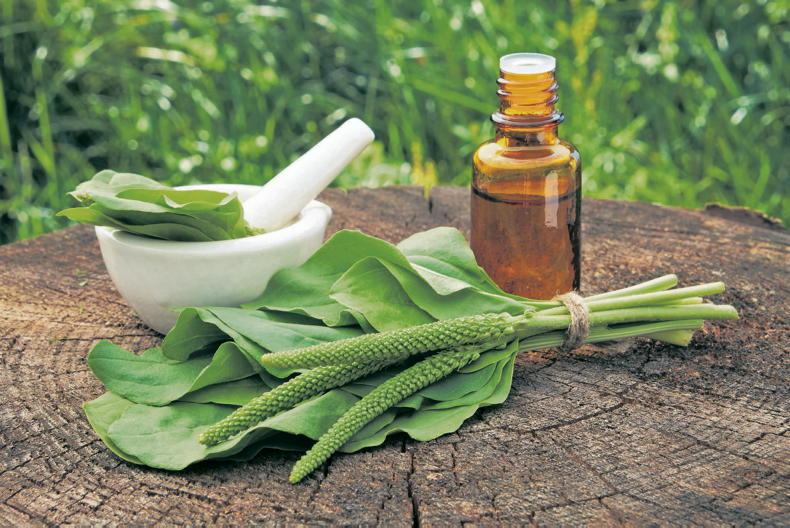Plantain (sometimes referred to as rib leaf) is a very common wild herb that is often regarded as a weed. It grows in a variety of habitats and in many parts of the world. You will find it in lawns (that have not been sprayed), roadside verges and most kinds of wild wasteland. Its leaves form a rosette close to the ground, sending up flowering stems to around 40cm high, in the case of Plantago lanceolata, and a somewhat shorter stem on the Plantago major.
There are many different varieties, but the two that I use are Plantago major (wide-leaved plantain) and Plantago lanceolate (narrow leaved plantain). These two varieties are interchangeable in their applications.
An unwelcomed sting
While doing a long-overdue tidy in my tunnel this week, I got stung by a queen wasp who didn’t appreciate me disturbing her winter sleep. At times like this, I am glad of my potions and lotions made during the warmer months of summer. The wasp sting was extremely painful, but with the application of my plantain salve, it was relieved within minutes.
For years, during horse-fly season, I lived in dread of their silent attacks. They land quietly and softly, generally on parts of your body that you can neither see nor reach, even managing to bite you through thick denim. They do, however, have the good manners to be slow, allowing you to crush them with a hearty slap. Unfortunately, this generally does not happen before they have drawn blood, leaving you with a nasty bite. The result is a large painful and itchy lump that remains for days and for some, even weeks.
I now always have my plantain salve to hand and find that if I manage to get it on the area of the bite in the first five minutes, it is gone in short order, leaving no trace. As well as neutralizing bites, I have successfully removed thorns and splinters with it.
It works like a poultice, because of its very good drawing properties. This results in it pulling irritants, foreign bodies, and inflammation from the skin while also having a calming and soothing effect.
Plantain contains several active compounds such as flavonoids, polysaccharides, terpenoids, lipids and iridoid glycosides. It is used in the treatment of various issues such as constipation, coughs, wounds, infection, bleeding, and inflammation.
To make plantain salve
Gather the plantain leaves on a dry day and leave to wilt somewhere warm for several hours. If you have a dehydrator and can dry the leaves completely, it does a better job - the extraction of the water content helps prevent the leaves from festering in the oil. The plants are at their best in late spring/early summer, so it is a good idea to gather and dry them at this stage. Store in a sealed container in a dark place for up to a year. This will give you a supply of material to use as needed.
When making the salve, pack the dry leaves into a jar, loosely filling it. Cover the leaves completely with almond or grapeseed oil. Cover with a lid and leave to infuse for about four weeks. Put it somewhere (out of direct sunlight), that you pass by on a frequent basis so that you can give it a shake regularly. This prevents leaves that might not be submerged in the oil, from drying out and going mouldy.
After four weeks, strain the infused oil through muslin.
Measure the oil and for every cupful, add 1oz of beeswax. The beeswax, as well as its beneficial properties, gives the salve the consistency of Vaseline, making it easier to apply to the skin.
Gently melt the oil and wax in a double saucepan or a glass bowl over a saucepan of boiling water. This prevents the mixture from overheating.
When fully mixed, pour into small tins or jars and label and date.
To use, apply the salve to the affected area three to four times daily.
I find it lasts for a full year or more, but I make up a new batch each year, using any previous year’s leftovers to polish my work boots.
If you are out and get bitten or stung and do not have your salve to hand, worry not: a spit poultice works equally well. Chew up some fresh leaves, spit out the pulp and place on the affected area.

Healing tea
Another healing application of the plantain is to use it to make tea. The tea can be made from either dried or fresh leaves. Put two to three chopped fresh leaves, or a large teaspoon of dried ones, into a cup and fill with boiling water. Cover and leave to infuse for approximately five minutes. This tea has wonderful healing properties for the respiratory system. With its high content of mucilage, which moistens and coats the airways, plantain gives great protection from the irritation of a dry cough.
It has a similar effect on the gut, with the mucilage coating the stomach and helping against the development of ulcers.
Plantain cordage
As a basket-maker, I also use the flower stalks to make a cordage (string), which I then weave into my wild foraged baskets. The cordage is made by twisting the long flower stems of the narrow leaved plantain. The stems are twisted individually in one direction and then two of the strands are plied together in the opposite direction. This makes a very strong cord which can also be used as a natural string.
*While Irene uses wild plants and herbs as part of her ‘first aid kit’ she stresses that she is not an herbalist and that you should do your own research.
About Irene
Gardening enthusiasts may have heard of Green Road Gardens in Ramsgrange, Co Wexford. Here, Irene Kelly delivers a variety of classes from her back garden including basket making, gardening, building live willow structures, vegetable and herb growing and many other topics. Check out greenroadgardens.ie
